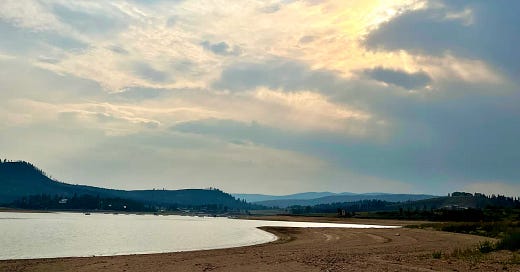If you’re enjoying the journey, don’t forget to hit the ❤️!
The next morning, our last half day in Rocky Mountain National Park, I enjoyed a leisurely walk with Koa around the campground and surrounding wilderness. Mike took his camera and went to photograph the large elk herds gathered in nearby meadows.
We both regretted that we’d only had one night to enjoy the park as we packed up and pulled the trailer out onto Trail Ridge Road, which leads to the western gate of the park. The same drive we hadn’t been able to see as we ate our hot dog picnic the night before, Trail Ridge is one of thirteen famous American Scenic Byways in Colorado. Carefully engineered for a mellow five percent grade and optimized for gentle curves and scenic overlooks, this departure from the park was a long, sweet goodbye; the perfect contrast to our adventure on Old Fall River Road in four-wheel-drive.
Once more we soaked in the views of the Rocky Mountains and the great, glacier-carved valley that held the Park in its cupped hands…and then we passed the Visitor Center at the top, and began the drive down and out of the park via its western gate. We were headed toward Grand Lake, a body of water and small town just outside the park’s perimeter where we had a reservation for the night.
As we descended from the magnificent views, we entered heavily fire-damaged, charred mountain slopes.
That’s when we discovered that the East Troublesome Fire had nuked the entire area around Grand Lake, including the town. When we planned the route to our next destination after Rocky Mountain NP, we didn’t know that we were driving directly through the East Troublesome’s deadly pathway as it roared its way through the mountains, a “super-fire blow-up,” the second-worst fire ever in Colorado history.
A “blow-up” is an event that can happen when wind, heat and drought, and an abundance of fuel (in this instance, dry lodgepole pine loaded with resin) converge for maximum destruction.
Mike and I had seen the results of a lot of fires on our travels and in our time in California, but this one had burned so hot that nothing but ash remained; entire forests were gone, leaving behind mere lumps of cinder. In less than a day, East Troublesome burned more than a hundred twenty thousand acres; at its height the blaze was unstoppable, consuming one hundred ninety-three thousand, eight hundred and twelve acres.
The campground at Grand Lake where we’d planned to stay was open, but had only recently scraped its sites out of the remains of blackened trees that still reeked of fire. After checking out our reserved site nestled in a bed of charcoal, we left without requesting a refund, feeling bad for folks trying to make a living on what was left behind by the devastation.
While I haven’t lived through a fire personally, I’d been evacuated five times since we moved to California only a few years before, and the memory of my brush with the fire in Yosemite still made me shiver. Camping in ashes did not appeal on any level.
Keep reading with a 7-day free trial
Subscribe to PASSAGES: Travel the USA and more! to keep reading this post and get 7 days of free access to the full post archives.



